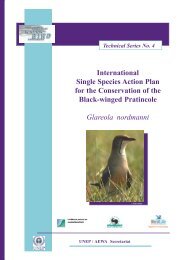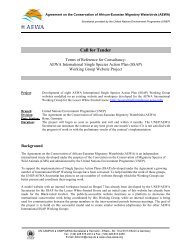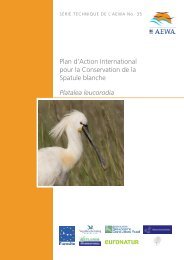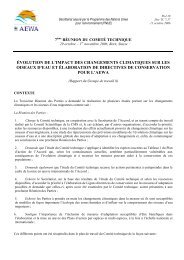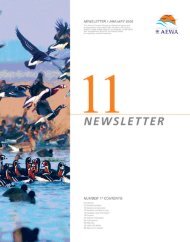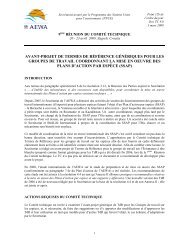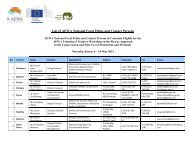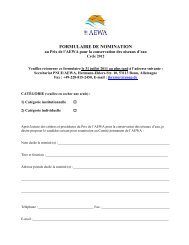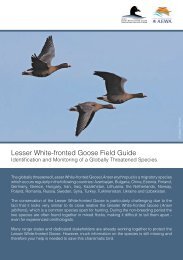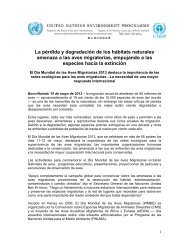International Single Species Action Plan for the ... - AEWA
International Single Species Action Plan for the ... - AEWA
International Single Species Action Plan for the ... - AEWA
You also want an ePaper? Increase the reach of your titles
YUMPU automatically turns print PDFs into web optimized ePapers that Google loves.
<strong>AEWA</strong> Technical Series No. 36 - Annexes<br />
Kolguev Island, north-west Russia in mid-July,<br />
where it remained <strong>for</strong> about one month,<br />
presumably to moult. Of two o<strong>the</strong>r individuals in<br />
this study that undertook moult migration, one<br />
went as far as <strong>the</strong> Taimyr Peninsula in Russia.<br />
(Aarvak & Øien 2003).<br />
Staging<br />
Autumn migration is more protracted than spring<br />
migration. Birds may remain at autumn staging<br />
sites into early winter in mild seasons. Spring<br />
migration typically appears to last from <strong>the</strong> second<br />
half of February until <strong>the</strong> end of May, but <strong>the</strong>re are<br />
again significant annual variations related to<br />
wea<strong>the</strong>r conditions.<br />
Wintering<br />
Satellite tracking and field observations suggest<br />
that birds typically reach <strong>the</strong>ir wintering grounds<br />
in <strong>the</strong> second half of November, remaining into<br />
late February or <strong>the</strong> first half of March, according<br />
to prevailing wea<strong>the</strong>r conditions.<br />
shallow on <strong>the</strong> opposite bank giving way to wet<br />
grassland and willow shrubs (Mineev & Mineev,<br />
2004). In <strong>the</strong> Polar Urals and Yamal Peninsula<br />
nests were located on rocky river cliffs and in<br />
dwarf birch tundra on watershed slopes close to<br />
rivers, and sometimes in mountain foothills. (V.<br />
Morozov, pers. comm.)<br />
In Siberia, nests are usually sited amongst<br />
vegetation, grass or dwarf shrub heath, often on<br />
snowfree patches available early in <strong>the</strong> season,<br />
such as rock outcrop or prominent hummock;<br />
often in proximity to open water or extensive<br />
marshy area (Dementiev & Gladkov 1952,<br />
reported by Fox 2005).<br />
Moulting<br />
In August 2000, a brief field survey was conducted<br />
of <strong>the</strong> area of Kolguev Island, north-west Russia,<br />
used in 1997 by a presumably moulting satellitetracked<br />
goose of <strong>the</strong> Fennoscandian population.<br />
The area was characterised by low-lying, flat<br />
tundra, dissected by ponds and small river valleys<br />
with slow-flowing streams. Vegetation was<br />
dominated by shrub (dwarf birch Betula and<br />
willows Salix) and tussock tundra with palsa mires<br />
(Strøm et al. 2001). According to studies in <strong>the</strong><br />
Bolshezemelskaya tundra and Yamal Peninsula,<br />
moulting areas occur on riverine areas with floodplain<br />
meadows and dense bushes/shrubs<br />
(Morozov, 1999).<br />
<strong>International</strong> <strong>Single</strong> <strong>Species</strong> <strong>Action</strong> <strong>Plan</strong> Lesser White-fronted Goose –Annexes<br />
II



